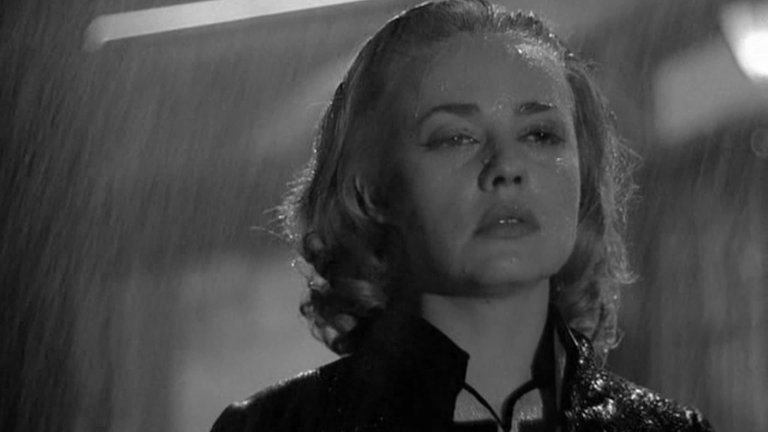Film Review: Elevator to the Gallows (Ascenseur pour l'échafaud, 1958)

In the realm of filmmaking, there are few directors who have earned a place in history books with their debut features. Louis Malle, a French filmmaker, belongs to this elite group for his 1958 thriller, Elevator to the Gallows, which has been lauded as one of the most important and influential films of its time, primarily due to its status as the first entry in what would come to be known as the French New Wave.
Adapted from Noël Calef's 1956 novel of the same name, Elevator to the Gallows weaves a complex narrative that unfolds against the backdrop of Parisian streets. The story commences on a fateful Saturday evening when Julien Tavernier (played by Maurice Ronet), a former paratrooper officer with a storied past in Indochina and Algeria, carries out a plan to murder his employer, the wealthy and influential businessman Simon Carala (played by Jean Wall). Egged by Carala's wife Florence (played by Jeanne Moreau), who is also his lover, Julien meticulously orchestrates the crime, making it appear as though Carala has taken his own life. However, in a moment of careless haste, the carefully laid plans begin to unravel.
As Julien finds himself trapped in an elevator while attempting to escape the scene of the crime, he unwittingly sets into motion a chain reaction of disastrous events. In the meantime, a young petty criminal named Louis (played by Georges Poujouly) steals Julien's car in order to impress his girlfriend Veronique (played by Yori Bertin), a florist. Couple embarks on a joyride that culminates in senseless violence and tragedy. As the drama unfolds, Florence spends the rainy night wandering the Parisian streets, becoming increasingly convinced that her lover Julien has backed out of their murderous plan and, worse still, has embarked on an affair with another woman.
Elevator to the Gallows is significant not only as the first New Wave film but also for its connections to the earlier tradition of film noir. The protagonist, played by Maurice Ronet, is a typical example of the genre – handsome, efficient, relatively well-off, yet unable to resist temptation in the form of a beautiful woman who leads him down a path of ruin. However, there are some elements that stray away from the film noir formula. For instance, the portrayal of women in the film deviates from the conventional femme fatale archetype. The most "fatal" woman in the movie is actually a ditzy and shallow teenager, while Florence, who would normally play the role of vampish seducer, spends much of the film as a victim, and ultimately tries to save her lover at great personal cost.
Louis Malle's experience working with oceanographer Jacques Cousteau on the famous documentary Silent World seems to have influenced his directing style in Elevator to the Gallows. He displays incredible skill in pacing the film, despite its hour-and-a-half running time. Together with co-writer Roger Nimier, Malle manages to craft an exciting tale filled with suspense and irony while also commenting on the emerging generational gap between rebellious teenagers, represented by Julien and Veronique, and older, more "serious" generations.
Malle also uses the film as a platform for social and political commentary on the increasingly bloody colonial wars, post-WW2 European unification, and corruption within French society. This aspect is best seen in the scene near the end when French police treat the wife of a politically connected businessman with kid gloves. However, this commentary is somewhat compromised by the film's conventional finale, which discards irony and coincidence in favor of a more straightforward approach where the forces of law and order, embodied by Commissioner Charrier (played by Lino Ventura), neatly wrap up the entire affair.
The film's black-and-white cinematography, captured by Henrie Decaë, creates an atmosphere of melancholy and doom both in claustrophobic interiors and Parisian exteriors. The nighttime cinematography is particularly effective, with Decae refusing to use extra lighting in the scenes featuring Florence's futile quest on the rainy streets. This approach not only enhances the film's visual appeal but also adds a layer of realism to Moreau's performance.
Jeanne Moreau, who had acted on film before, benefited greatly from Malle's direction and the cinematography by Decae. Without heavy makeup or artificial lighting, her acting looks more realistic and genuine, making her one of the icons of French and world cinema. Her performance as Florence is a testament to Malle's ability to elicit exceptional performances from his actors.
Finally, the music score by legendary jazz trumpeter Miles Davis adds a layer of atmosphere to the film that is unmatched. Even some US critics who otherwise found Malle's work disappointing praised Davis' work as one of the finest soundtracks in cinematic history.
Elevator to the Gallows stands as a testament to Louis Malle's prodigious talent and his ability to craft compelling narratives that resonate with audiences even half a century after their initial release. Additionally, the film has been remade twice – in 2010 by Japanese director Akira Ogata and in 2013 under the title Weekend by Russian director Stanislav Govorukhin.
RATING: 8/10 (+++)
Blog in Croatian https://draxblog.com
Blog in English https://draxreview.wordpress.com/
InLeo blog https://inleo.io/@drax.leo
Hiveonboard: https://hiveonboard.com?ref=drax
Rising Star game: https://www.risingstargame.com?referrer=drax
1Inch: https://1inch.exchange/#/r/0x83823d8CCB74F828148258BB4457642124b1328e
BTC donations: 1EWxiMiP6iiG9rger3NuUSd6HByaxQWafG
ETH donations: 0xB305F144323b99e6f8b1d66f5D7DE78B498C32A7
BCH donations: qpvxw0jax79lhmvlgcldkzpqanf03r9cjv8y6gtmk9
Posted Using InLeo Alpha
No he visto esta película, gracias por la recomendación.
Saludos @drax